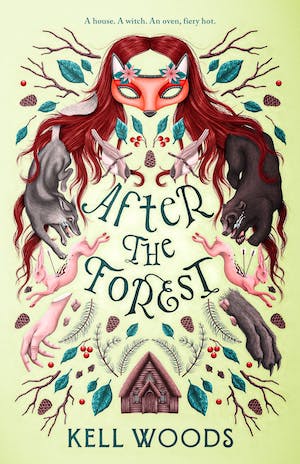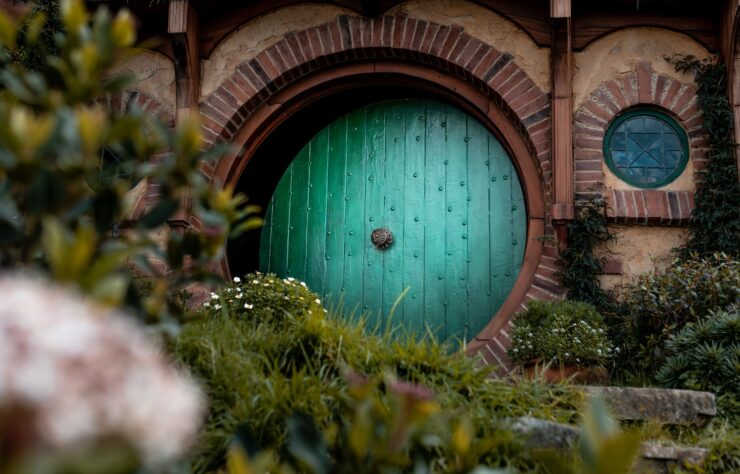Allegorical readings of The Lord of the Rings vexed Tolkien. In the Foreword to the second edition of the books, he wrote of his distaste for allegory altogether: “I much prefer history, true or feigned.” The environmentalism that’s evident throughout his chronicles of Middle-earth, from the rebellion of Fangorn Forest to the Scouring of the Shire to the destruction of the Two Trees of Valinor? That was all based in history and autobiography, from a childhood in which “the country in which I lived was being shabbily destroyed before I was ten,” only made mythic.
Before I was ten, the third in a series of international scientific reports on our warming Earth was published, and the Kyoto Protocol set targets for countries to reduce their greenhouse gas emissions. Prior to those developments, Svante Arrhenius had connected the burning of coal to rising carbon dioxide levels and hotter climates; John Tyndall had identified the gases responsible for the greenhouse effect; and Eunice Foote had realized that carbon dioxide gas could trap heat from the sun. In fact, Arrhenius did his work long before I was born, near the beginning of Tolkien’s own lifetime; Tyndall and Foote, before Tolkien was born.
When it comes to what is true and what has been feigned, the historicity of climate change is an established fact, and the willful denial of its reality is a toxic fiction. Climate change was already occurring during the years when Tolkien lived and wrote. Though he may not have been aware of a growing knowledge of global warming, I think his work is directly applicable to all of us who face the current onslaught of frightening headlines about climate disasters and think, like Frodo, “I wish it need not have happened in my time.” Tolkien, if not a professed environmentalist, was certainly a pastoralist, a lover of trees and countryside and an opposer of polluting industrialization. Ents, Eagles, Beornings, and other forms of nature personified fill his work, as do plot points and revelations that hinge on the destruction of one or more trees (or Trees). His letters put it even more plainly: “The savage sound of an electric saw is never silent wherever trees are still found growing.” Climate change is industrial deforestation writ large. For me, there’s no author who gives the natural world its due the way Tolkien does.
With Amazon’s The Rings of Power series driving a new pop-cultural wave of interest in Middle-earth at the same time global temperatures are shattering records and driving extreme weather events around the world, I’ve found myself longing for Tolkien or a Tolkien-like voice of the twentieth-first century: Someone pouring out words about the living world, writing that emerges from unabashed, earnest love for nature. The mounting threat of climate change has me returning to my childhood favorites to seek wisdom for these long defeats in this Century of Disasters, to look for a light forward in dark times for the planet and its inhabitants.
My favorite of all Tolkien’s works is The Silmarillion. By far the most beautiful, it’s the legendarium of Middle-earth and of Arda, the detailed mythos that evokes the Metamorphoses, the Kalevala, and Beowulf. In places that readers encounter throughout The Silmarillion and elsewhere in Tolkien’s writing—Lothlórien, Doriath, and Mirkwood—we observe Elves (or at least, Sindarin Elves) living in symbiosis with the forests and landscapes around them. But though Gondolin, Hidden City in the mountains, takes advantage of its geography to seal itself away from the rest of Beleriand and Morgoth’s forces, the city bounds itself behind high walls that serve to keep in as well as out. The decision of the Gondolindrim to remain behind in their hidden valley, willfully ignorant to the plight of both Elves and Men suffering Morgoth’s rein of fire beyond, proves tragically short-sighted.
By this point, many of the Noldor may be called artificers more than environmentalists. Gondolin’s king, Turgon, is even warned by the god Ulmo to not love “too well the work of thy hands.” Turgon twice ignores the Vala’s warnings, and ultimately it’s Turgon’s own nephew who is turned to treachery by Morgoth. The city falls to Morgoth’s monsters of shadow and fire; those who escape Gondolin make their way out, amidst smoke and confusion, only through the preparation of Turgon’s daughter Idril. If you’d like to read this allegorically in our current age of climate disasters—is a Balrog or a dragon any worse than a raging wildfire?—this makes the survivors of the fallen Gondolin climate refugees. They aren’t the last; by the time the First Age ends with the War of the Valar, the geography and, in some ways, the ecology of Middle-Earth has been drastically remade. Beleriand is sunk beneath the waves, perhaps a third of the continent of Middle-earth lost. Its inhabitants (those that can’t or won’t sail for Valinor) migrate to Lindon and points farther eastward, onto the regions of the map readers will recognize from the Second Age and onwards.
Is this the “correct” way to read The Silmarillion? The allegory doesn’t fully hold; it might even be verging onto the borders of fanfiction. Still, in subsequent printings of The Lord of the Rings, Tolkien acknowledged applicability even as he dismissed allegory, writing in the Foreword that many people often confused the two. I find applying a lens of climate change to be helpful, even hopeful, in considering the resilience and survival of Tolkien’s characters who, like Idril and Tuor, possessed the foresight and courage to recognize and plan for against false hope.
In The Fellowship of the Ring, Galadriel—who was not present at the Fall of Gondolin but survived numerous other (un)natural disasters—tells the members of the Fellowship that she and Celeborn have been for ages fighting “the long defeat.” The destruction of the Ring and the end of Sauron will bring to the Elves both victory and defeat, as the power of their own rings fades and they must pass away. It’s in Lothlórien that Sam looks into Galadriel’s Mirror and sees the ravaging of the Shire—not merely a premonition, as the four Hobbits of the Fellowship later discover. After the Ring is destroyed and they journey homeward, they are greeted by the gated, burned, and ruined Shire in the penultimate chapter of the epic tale. The destruction of the green and peaceful countryside evokes everything that runs counter to Tolkien’s environmentalism: Ugly ramshackle houses where trees once stood; the Bywater and Hobbiton blackened, polluted, and burnt; the wanton destruction of trees and woods seemingly for the fun of it; and at Bag End, Saruman, with his infamous “mind of metal and wheels.”
Floating above it all, literally, is the black smoke and stench of coal used to fire the mills. Tolkien didn’t need to be a chemist to recognize that the combustion of coal would forever alter the landscape of a place, nor did Farmer Cotton need to be an ecologist to understand that if Sharkey/Saruman wanted “to make the Shire into a desert, [he was] going the right way about it.” The experiences of Frodo, Sam, Merry, and Pippin are more than a cautionary tale warning that adventurers don’t return from their adventures unchanged. The Shire itself is changed. As both Sam and Saruman point out in different ways and with different words, the changes are hard to undo when it’s your home on the front lines. Perhaps, like Sam (before he remembers his Galadriel-given Elven dust and begins replanting), you’re left to wonder how many generations will pass until your descendants will be able to see the trees as you once did.
Buy the Book


After the Forest
The Scouring of the Shire and its aftermath is not simply pro-tree—it’s pro-stewardship and anti-pollution. The shadow of defeat touches every front. There are, right now, people on our Earth fighting Big Oil and Big Pipeline on the largest global stages, but there also people in their hometowns resisting the latest attempt to revive an incinerator, expand a cancer-causing plastics plant, or run a liquefied natural gas train through the center of it all. Pro-tree, anti-pollution—it’s all part and parcel of addressing the complex system of entanglements that is climate change, that is biodiversity loss, that is a long, sobering series of ecological disasters and defeats.
After the Hobbits band together and take back the Shire from Sharkey/Saruman, it’s Sam Gamgee who carries on the cause, drawing back upon a family legacy of stewardship of the land and all that live upon it. The Sam Gamgees of the world are those who take a stand and say, “I shan’t call it the end, till we’ve cleared up the mess.” It’s an idea present throughout the tales of Hobbits, culminating in Farmer Cotton and the Shire-folk rising together to trap Sharkey’s ruffians, once Merry and Pippin light the spark of rebellion in them. The same idea traces its way back hundreds of pages to the formation of the Fellowship in Rivendell. There are certainly ways to map the monomyth or any of the many modern formulations of the Hero’s Journey structure onto The Lord of the Rings, including the Return to the Ordinary World via the Scouring of the Shire. But I don’t read Frodo’s story that way. For one thing, we know that Frodo fails in the final moments of his quest and it’s Gollum (and Sam!) who make sure the Ring is destroyed. For another, inherent in the very creation of the Fellowship of the Ring is the knowledge that the task is far too big for anyone to accomplish alone.
Aragorn is a king, but his return to Gondor means nothing if the Ring isn’t destroyed. Boromir is noble but is betrayed by his own self-inflated ideas of heroism. Gandalf has demigod-like powers, but acknowledges that even someone as powerful as an Elf-Lord can’t storm Mordor to make a path for Frodo. The other members of the Fellowship aren’t simply sidekicks or mentor figures for Frodo. They fight (metaphorical and literal) battles both on the pages and in the background, in spite of very uncertain outcomes for themselves and for the Quest as a whole.
In a book published in 2016 called The Great Derangement, author Amitav Ghosh argued that up to that point, the amount of fiction (or at least, literary fiction) that reckoned with climate change was miniscule in proportion to the scale and reach of the crisis. While I think that’s changing (better late than never), maybe a little bit of revisionist rereading is in order to narrow the gap between what is and what yet may be. Rereading Tolkien, not for the promise of allegory but for the possibility of parallels that apply to our current circumstances, offers comfort, wisdom, and warnings. The path forward won’t be easy, and there is no messiah-like figure coming to save us from climate change. We’re all Hobbits now.
Alyssa Hull is a writer, educator, and recovering scientist who lives in the small (but charming) state of Delaware. Her writing has previously appeared at McSweeney’s and Literary Hub.










